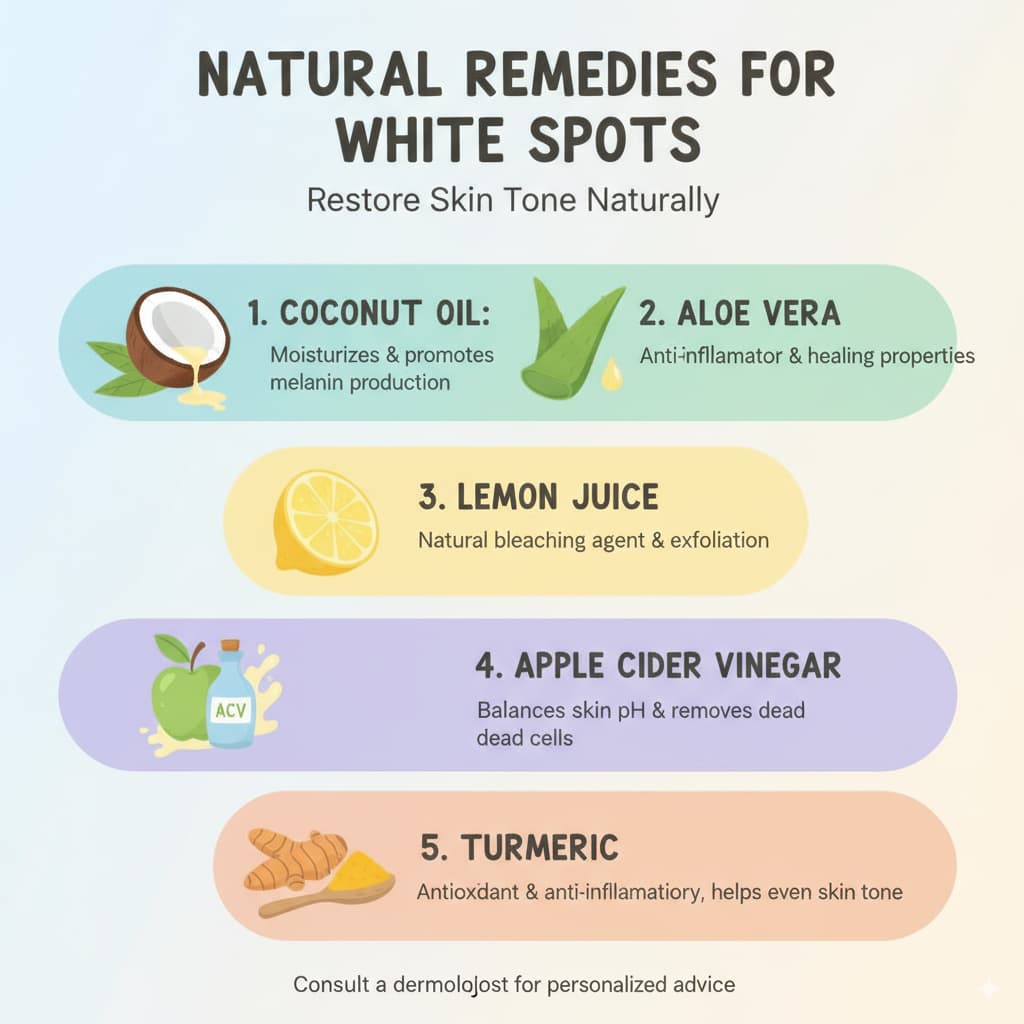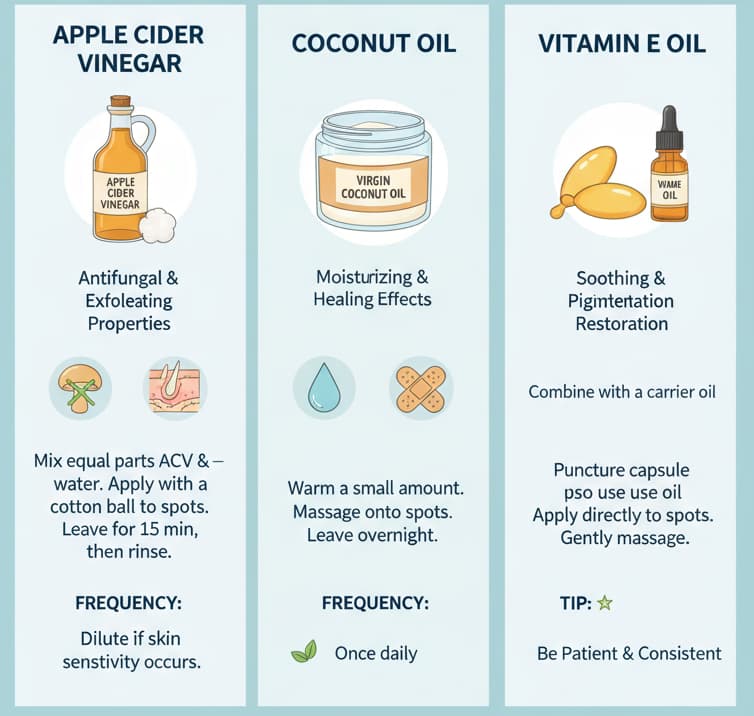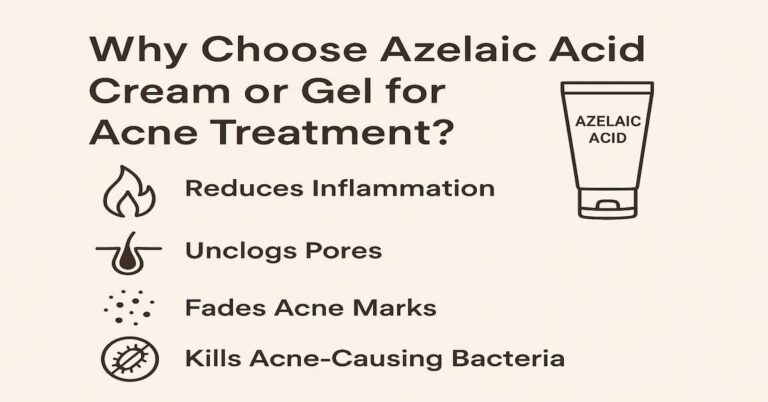White spots on the skin can be frustrating and sometimes even concerning. These spots might appear due to various factors, such as fungal infections, vitamin deficiencies, or conditions like vitiligo. While there are medical treatments available, many individuals in the UK prefer to try natural, cost-effective solutions for managing and treating white spots. This guide explores the top 5 natural remedies you can use to help reduce the appearance of white spots and restore your skin’s natural tone.

1. Turmeric and Mustard Oil Paste
Turmeric has long been used for its potent anti-inflammatory, antimicrobial, and antioxidant properties. It contains curcumin, which is known for its ability to reduce inflammation and improve skin health. When combined with mustard oil, this paste may help restore pigmentation and reduce the appearance of white spots caused by vitiligo.
- How to Use: Mix a teaspoon of turmeric powder with mustard oil to form a thick paste. Apply this paste directly to the affected areas. Leave it on for around 20 minutes before rinsing off with lukewarm water.
- Frequency: You can use this remedy 2-3 times a week for the best results.
- Tip: Always perform a patch test before applying to a larger area to ensure there’s no allergic reaction.

2. Neem Leaves
Neem has been used in traditional medicine for centuries due to its antifungal, antibacterial, and antiviral properties. White spots caused by fungal infections, such as tinea versicolor, may benefit from neem’s powerful healing abilities.
- How to Use: You can either crush fresh neem leaves into a paste and apply it to the white spots or use neem oil. Leave it on for about 20-30 minutes before rinsing with water. Alternatively, you can boil neem leaves in water and use the cooled solution to wash the affected areas.
- Frequency: Apply neem paste or oil once daily, and you should begin to see improvements in a few weeks.
- Tip: Neem can be quite potent, so start by using it on a small area of skin to test for sensitivity.
3. Apple Cider Vinegar
Apple cider vinegar (ACV) is known for its antifungal properties due to the presence of acetic acid. It can be particularly useful for treating white spots caused by fungal infections. ACV also has skin-exfoliating qualities, which may help remove dead skin cells and promote the regrowth of healthy, pigmented skin.
- How to Use: Mix equal parts of water and apple cider vinegar. Using a cotton ball, apply the diluted solution to the affected areas. Leave it on for 10-15 minutes before washing it off with lukewarm water.
- Frequency: Use this remedy 3-4 times a week to see noticeable results.
- Tip: Always dilute ACV before applying it to the skin, as its acidity can be harsh on sensitive skin.

4. Coconut Oil
Coconut oil is packed with fatty acids, such as lauric acid, which have antimicrobial properties. It helps moisturize and heal the skin, and it can also be effective in treating white spots caused by fungal infections. Coconut oil’s soothing properties make it an excellent option for those looking to keep their skin hydrated and promote faster healing.
- How to Use: Apply a small amount of virgin coconut oil directly to the white spots and massage gently in circular motions. Leave it on for a few hours or overnight for maximum benefits.
- Frequency: You can use coconut oil daily to maintain healthy skin and reduce the appearance of white spots.
- Tip: Look for organic, cold-pressed virgin coconut oil for the best results.
5. Vitamin E Oil
Vitamin E is well-known for its ability to repair skin damage and promote healthy skin regeneration. It is an antioxidant that helps improve pigmentation and may gradually restore the color to areas of skin affected by white spots. Vitamin E oil can also help hydrate and soothe the skin, which is essential for effective healing.
- How to Use: Break open a vitamin E capsule and apply the oil directly to the affected areas of the skin. Massage the oil gently in circular motions. Leave it on overnight and rinse in the morning.
- Frequency: Apply vitamin E oil nightly for best results.
- Tip: If you have sensitive skin, do a patch test first to ensure no irritation occurs.
Additional Tips for Treating White Spots

- Healthy Diet: Ensure that you are getting a balanced diet rich in vitamins and minerals. Deficiencies in certain vitamins, such as Vitamin D, B12, or copper, can lead to the development of white spots on the skin. Include more fruits, vegetables, and whole grains in your meals.
- Sun Protection: While sunlight is essential for producing Vitamin D, it’s important to protect your skin from harmful UV rays. Use sunscreen daily to prevent further damage and keep the skin protected from discoloration.
- Avoid Scratching: White spots can become irritated or inflamed if scratched. Avoid scratching or rubbing the affected areas to allow the skin to heal naturally.
- Consult a Dermatologist: If the white spots persist or worsen despite using natural remedies, it is crucial to seek professional advice. A dermatologist can help diagnose the condition accurately and suggest appropriate treatments.
FAQ – Common Questions About White Spots on Skin
1. What causes white spots on the skin?
White spots can be caused by several factors, including fungal infections (e.g., tinea versicolor), vitiligo, or vitamin deficiencies (particularly Vitamin D, B12, and copper). Fungal infections are one of the most common causes, and they often result in patches of lighter skin.
2. Can home remedies treat white spots effectively?
Yes, many home remedies can help reduce the appearance of white spots, especially if they are caused by fungal infections. Ingredients like turmeric, neem, and apple cider vinegar have been shown to help with pigmentation restoration. However, results can vary, and consistency is key.
3. How long will it take for the white spots to go away?
The time required for white spots to fade depends on the underlying cause. For fungal infections, it might take 2-4 weeks of regular treatment with home remedies. For vitiligo or other conditions, it may take longer, and you may need professional treatments.
4. Are there any side effects to using natural remedies?
While natural remedies are generally safe, some people may experience skin irritation, especially with potent ingredients like apple cider vinegar or neem. Always perform a patch test before using any remedy on larger areas of skin.
5. Can white spots come back after treatment?
Yes, white spots can sometimes return if the underlying cause isn’t properly addressed. It’s important to continue using remedies or follow-up treatments as recommended by a healthcare professional, especially in cases like vitiligo or fungal infections.
6. Is it safe to use coconut oil for white spots?
Coconut oil is generally safe for use on the skin, especially for its moisturizing and antimicrobial properties. However, if you have sensitive skin, it’s always a good idea to test it on a small patch first to avoid any allergic reactions.
Conclusion
White spots on the skin may seem like a cosmetic issue, but they can have deeper causes that require attention. While professional treatment may be necessary for conditions like vitiligo, natural remedies like turmeric, neem, coconut oil, and vitamin E can help treat white spots caused by fungal infections or mild skin issues. As with any skin treatment, consistency and patience are crucial. Always keep an eye on your skin’s response and consult a dermatologist if the condition worsens or persists.



